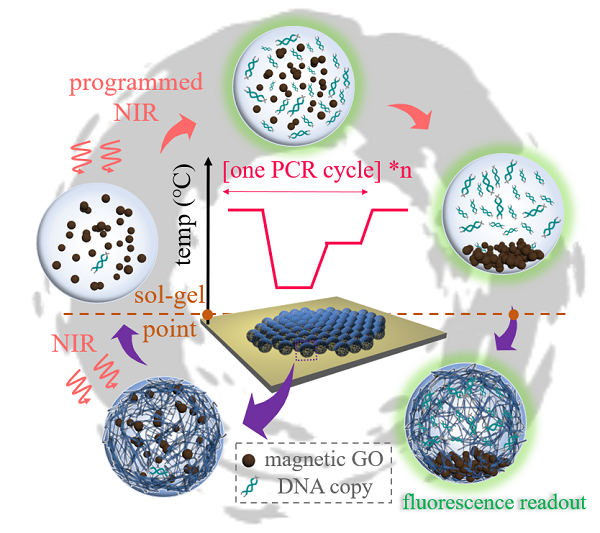- Newsroom
- Research Progress
- Academic Events
- Join Us
Near-Infrared Responsive Droplet for Digital PCR
2022-06-20
Facing the development of rapid nucleic acid detection technology, Fangfu Ye’s team developed a novel light-mediated temperature control approach using near-infrared (NIR)-responsive hydrogel microcarriers to solve the challenges of complicated instruments and aqueous drop evaporating in the droplet digital polymerase chain reaction (ddPCR). Based on this intelligent responsive ddPCR technique, the team have demonstrated the feasibility and rapidity for the detection of Klebsiella pneumoniae DNA in a large concentration range. This work is expected to be applied to on-site nucleic acid detection and play an important role in epidemic prevention and control in the future.

Figure 1. Schematic illustration of the NIR responsive droplet dPCR.

Figure 1. Schematic illustration of the NIR responsive droplet dPCR.
A near-infrared (NIR) controlled thermocycling approach by embedding magnetic graphene oxide (GO) composite into the agarose microcarriers is developed. The core-shell composite is constructed by sequentially encapsulating GO and silica outside the magnetic nanocores. Benefiting from these additives, the resultant composite agarose gains appealing features as light-driven temperature changing, switchable gel-sol phase transforming, biocompatibility, and magnetic traction. By further emulsifying into droplets via the microfluidics method, the influence of typical parameters including material loading amount, laser intensity, and droplet diameter at various ranges is investigated for assembling microcarriers with different responsiveness. Then a paradigm of the NIR program can be easily tailored for PCR thermocycling. Finally, the feasibility of the approach is verified by detecting statistically diluted Klebsiella pneumoniae DNA samples, from 0.1 to 2 copies per drop. It is anticipated that this method has promising prospects for dPCR-based and other temperature-controlled applications. This research extends the diversity of the structure and function of smart biomaterials to the droplet digitalization assays. The related research results were published in the Small journal (IF: 13.281) with the title of “Near-Infrared Responsive Droplet for Digital PCR”.
This paper is a collaborative work between WIUCAS and the Joint Medical Transformation Center of the First Affiliated Hospital of Wenzhou Medical University, Nanjing Drum Tower Hospital, Oujiang Laboratory, and Institute of Physics in Chinese Academy of Sciences. The first author is Lexiang Zhang, associate researcher of WIUCAS; and the corresponding author is PI Fangfu Ye of WIUCAS. This work was supported by the Strategic Priority Research Program of Chinese Academy of Sciences (Grant No. XDB33030300), the National Key Research and Development Program of China (2020YFA0908200), Zhejiang Provincial Natural Science Foundation of China (LGF22C100003), and the program of WIUCASQD2021012 from WIUCAS.
This paper is a collaborative work between WIUCAS and the Joint Medical Transformation Center of the First Affiliated Hospital of Wenzhou Medical University, Nanjing Drum Tower Hospital, Oujiang Laboratory, and Institute of Physics in Chinese Academy of Sciences. The first author is Lexiang Zhang, associate researcher of WIUCAS; and the corresponding author is PI Fangfu Ye of WIUCAS. This work was supported by the Strategic Priority Research Program of Chinese Academy of Sciences (Grant No. XDB33030300), the National Key Research and Development Program of China (2020YFA0908200), Zhejiang Provincial Natural Science Foundation of China (LGF22C100003), and the program of WIUCASQD2021012 from WIUCAS.